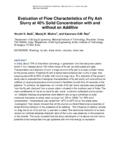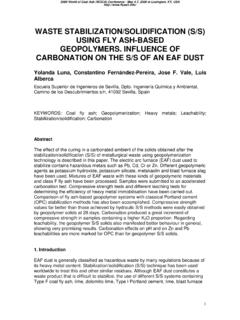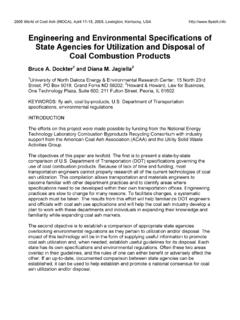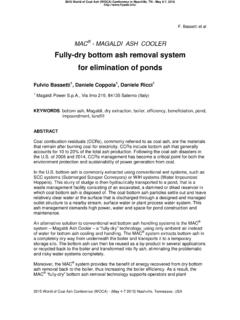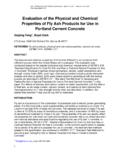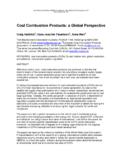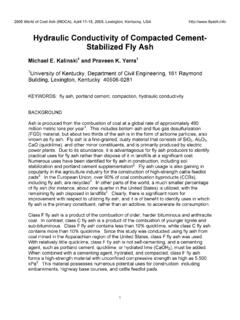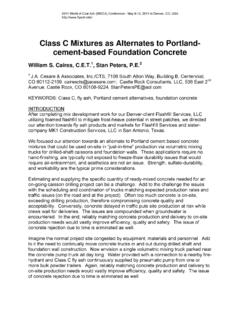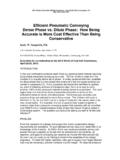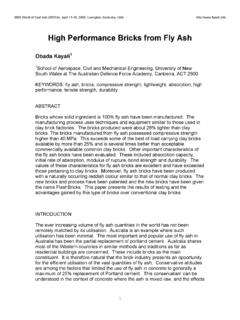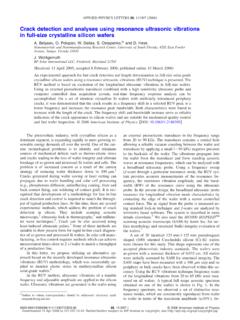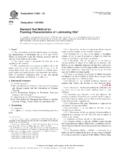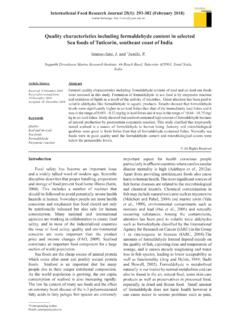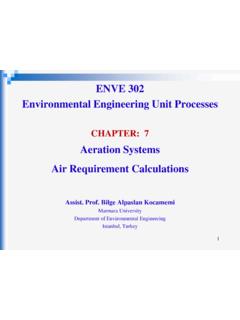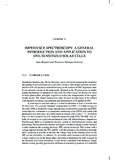Transcription of Fly Ash Cenospheres: Composition, Morphology, …
1 Fly ash cenospheres : Composition, morphology , structure , and Helium Permeability Elena V. Fomenko1, Natalia N. Anshits1,2, Marina V. Pankova1,2, Leonid A. Solovyov1, and Alexander G. Anshits1,2 1 Institute of Chemistry and Chemical Technology, Siberian Branch, Russian Academy of Sciences, ul. Karla Marksa 42, Krasnoyarsk, 660049 Russia 2 Siberian Federal University, Svobodny pr. 79, Krasnoyarsk, 660041 Russia KEYWORDS: cenospheres , mullite, helium permeability ABSTRACT The interrelation between the composition, morphology , structure , and helium permeability of the shells of narrow fractions of nonmagnetic non-perforated cenospheres has been investigated. The narrow fractions of nonmagnetic non-perforated cenospheres have been separated from concentrates of cenospheres of the sialic fly ash type with the use of the technological scheme, including stages of hydrodynamic gravitational separation, magnetic separation, grain-size separation, and aerodynamic classification.
2 It has been established that, in the range of variation in the Al2O3 content from 20 to 38 wt %, the concentrations of the major components of the chemical composition of the products obtained are related by a linear regression equation with a correlation coefficient of It has been found that, when the Al2O3 content changes in the range from 20 to 38 wt %, the content of the mullite (0) phase increases from to wt %, which leads to an increase in the helium permeability of the glass-crystalline shell of the cenospheres by more than two order of magnitude. The equilibrium devitrification of the glass phase of the cenosphere shell results in the formation of small (17 33 nm) crystallites of the mullite (I) phase, which, in turn, leads to the formation of additional interfaces for selective diffusion of helium.
3 INTRODUCTION At present, membrane technologies used for separating gas mixtures have been intensively developed 1 and, consequently, have required to design and fabricate selective membranes characterized by the high permeability, enhanced mechanical strength, high thermal stability, and increased chemical resistance. Selective membranes have been fabricated from inorganic and polymer materials in the form of planar, tubular, and spiral elements 2. Damage of these constructions in the course of World of Coal Ash (WOCA) Conference - May 9-12, 2011, in Denver, CO, USA operation leads to a drastic decrease in the quality of the separation of gas mixtures. The efficiency of separation of gas mixtures has been increased using closed hollow membrane elements.
4 For this purpose, it is customary to use expensive synthetic glass microspheres based on borosilicate glass 3, 4, which have been subjected to additional treatment (acid etching, doping with rare-earth and transition metals) for increasing the membrane permeability. The prospects for the use of silicate glasses as membranes are determined by a combination of their high permeability for helium and hydrogen with a very low diffusion permeability with respect to oxygen, nitrogen, methane; moreover, the selectivity of separation of the helium nitrogen and helium methane gas mixtures reaches high values of 105 106. This is one of the significant technological advantages of silicate glass membranes over polymer membranes 5. The phase transformations observed in glasses and accompanied by the crystallization of phases exert a profound influence on the diffusion properties.
5 In glass-crystalline materials, the diffusion of helium proceeds in two different paths: (i) through the anion sublattice of the glass phase and (ii) along the "crystal glass phase" interfaces. The contribution from each path to the overall process of diffusion depends on the temperature. In particular, for samples of quartz glass containing cristobalite crystallites, the lattice diffusion of helium with an activation energy of 24 kJ/mol is more preferential at a temperature above 300 C, whereas the diffusion of helium along the "cristobalite glass phase" interfaces with an activation energy of 18 kJ/mol 6 becomes preferential in the low-temperature range 0 110 C. For the use in the design of selectively permeable membranes intended for separation of gas mixtures, as well as for sorption and storage of the desired components, for example, helium and hydrogen, hollow microspheres with a thin glass-crystalline shell providing an increased permeability and an enhanced mechanical strength are of special interest.
6 These microspherical membranes can be fabricated from glass-crystalline cenospheres of fly ashes, because the specific features of their morphology and phase-mineral composition determine new prospects for the preparation of modern functional materials based on these cenospheres . cenospheres or aluminosilicate hollow microspheres represent one of microspherical components of the sialic fly ashes type 7, which are characterized by a low bulk density ( g/cm3) and can be easily separated by the gravitational methods in the form of a concentrate in aqueous media 8, 9. The content of cenospheres in fly ashes from the combustion of different types of coals varies over a rather wide range from to wt % and, in the majority of cases, amounts to wt % 9-14.
7 The formation of cenospheres occurs as a result of thermochemical and phase transformations of the original mineral coal forms in the course of their combustion. The granulometric, chemical, and phase-mineral compositions of the cenospheres depend on the composition of the original coal, the type of furnaces employed, the conditions used for cooling melt droplets, etc. 9, 11-16. The results presented in the literature on the investigation of the concentrates of fly ash cenospheres from the combustion of different types of coals 9, 11, 14, 16-23 have clearly demonstrated the inhomogeneity of their granulometric, phase-mineral, major component, and minor component compositions . It has been shown that the concentrates of cenospheres are represented by mixtures of hollow spherical particles with sizes ranging from 5 to 500 m 9, 10 and a shell thickness varying from 2 to 30 m 9, 11, 13, 19.
8 According to their chemical composition, the concentrates of cenospheres are the SiO2 Al2O3 Fe2O3 CaO MgO Na2O K2O TiO2 multicomponent systems in which the contents of the major components vary in the following ranges: 50 65 wt % SiO2, 20 36 wt % Al2O3, and 2 10 wt % Fe2O3 9-11, 17. The glass-crystalline shell of cenospheres is a multiphase system consisting of the glass phase (50 90 wt %) and the crystalline phases of mullite, quartz, cristobalite, calcite, potassium feldspar, hematite, and magnetite9, 10, 24. The outer and inner surfaces of the cenospheres are covered by a nanometer-sized film with a thickness ranging from 30 to 50 nm 25. The different chemical and phase-mineral compositions of the cenospheres determine the diversity of morphological types of globules 16, 17, 19, 22, among which are thin-walled spheres with a continuous shell, spheres with porous shells, spheres containing numerous silicate globules within their volumes, perforated spheres, and spheres with a network structure .
9 The narrow fractions of cenospheres with certain composition, morphology , thickness, and porosity of the shell can be considered as promising microspherical membranes with a predicted permeability with respect to helium and hydrogen. In this paper, we have presented the results of our investigation of the composition, morphology , structure , and helium permeability of the shells of globules of narrow fractions of nonmagnetic non-perforated cenospheres , as well as the preparation of microspherical membranes based on these cenospheres with a mullitized shell. EXPERIMENTAL The methodology developed for producing narrow fractions of nonmagnetic non-perforated cenospheres with a constant composition from concentrates with a variable composition26 is based on one of the fundamental principles underlying the physicochemical analysis of functional materials, which determines the "composition morphology structure properties" relationship and includes the system for sampling and controlling the quality of products at all stages of the technological process.
10 The raw materials used for the preparation of narrow fractions of nonmagnetic non-perforated cenospheres were concentrates of cenospheres of the sialic fly ash type taken from the Novosibirsk Heat and Electric Power Plant No. 5 (series N) and the Moscow Heat and Electric Power Plant No. 22 (series M), which have burnt coals from the Kuznetsk Basin (Russia) at temperatures of 1500 and 1650 C in the core of the flame, respectively, as well as those taken from the Reftinsk Hydroelectric Power Station (series R), which has burnt coals from the Ekibastuz Basin (Russia) at a temperature of 1600 C. The separation of narrow fractions of nonmagnetic non-perforated cenospheres was performed with the use of the technological scheme 26, including stages of hydrodynamic gravitational separation, magnetic separation, grain-size separation, and aerodynamic classification with the subsequent hydrostatic separation of broken globules.
